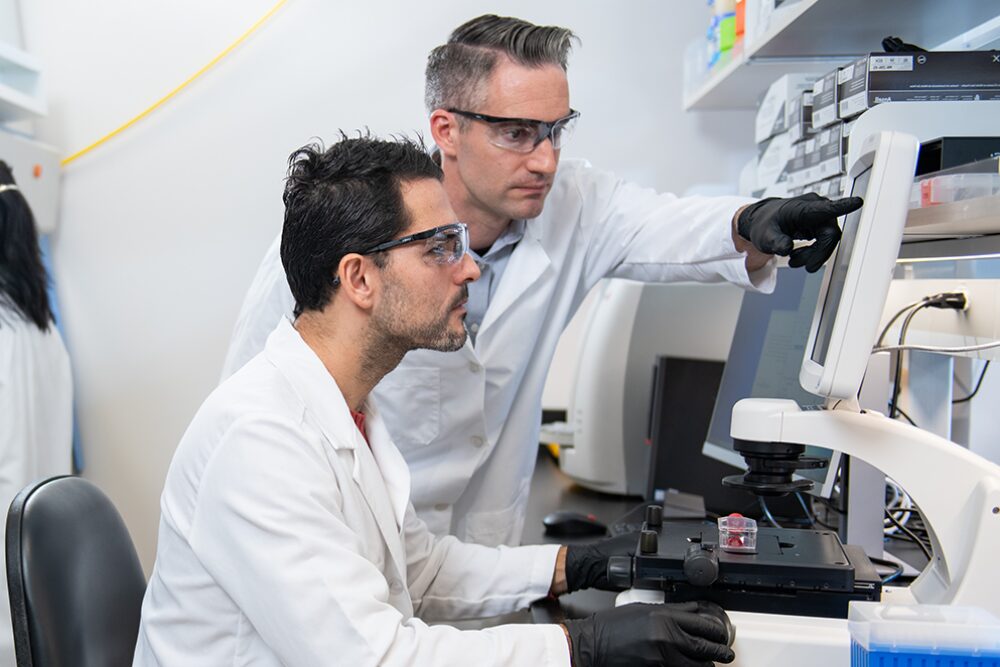May 25, 2022
Member Spotlight: Erasca
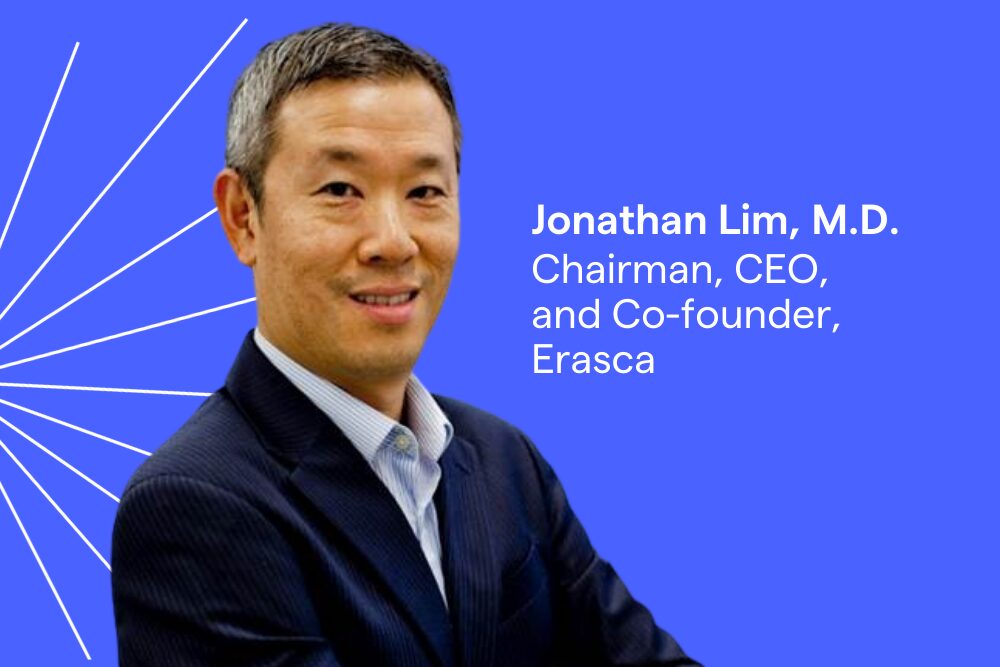
Erasca is on a mission to erase cancer and develop precision oncology treatments that potentially address millions of patients globally
In celebration of Asian American and Pacific Islander Heritage Month, we are highlighting AAPI leaders in life science. Jonathan Lim started his career as a surgeon, which led him to cancer research and later venture capital, and eventually becoming CEO of Halozyme Therapeutics in 2003. Dr. Lim went on to lead a total of six biotech companies since, and today he’s the CEO and co-founder of Erasca, a San Diego-based precision oncology company focused on developing treatments for RAS and MAPK pathway-driven cancers. When mutated, the RAS family of oncogenes within the mitogen-activated protein kinase (MAPK) pathway causes roughly one-third of all cancers in humans. Erasca is currently researching and developing 11 precision oncology treatments for cancer and hopes to make these targeted therapies available to more patients in the future.
Erasca has had a very busy year. Last month, the company announced a clinical trial and collaboration with Eli Lilly for cetuximab (ERBITUX), made an equity investment in Affini-T Therapeutics, and hired new employees. What is the next big thing in store for your company?
Over the past year, we’ve assembled and advanced the deepest RAS/MAPK pathway-focused pipeline in the industry, enabling us to investigate treatments with the potential to address the significant unmet need for about 5.5 million patients per year diagnosed with cancers driven by mutations in this pathway. In the second half of this year, we are looking forward to multiple clinical trial readouts from our lead programs, ERAS-007 and ERAS-601, which target ERK and SHP2, respectively. ERAS-007’s biochemical characteristics have the potential to make it not just a first-in-class, but best-in-class ERK inhibitor. While multiple objective responses were previously observed with ERAS-007 in a Phase 1 monotherapy study, we are eagerly anticipating clinical data looking at ERAS-007 in various combinations where we believe the molecule can significantly improve standard-of-care for patients. We are also looking forward to safety and pharmacokinetic data from ERAS-601—our potential best-in-class SHP2 inhibitor which is designed to block oncogenic signaling and delay the onset of resistance from RAS/MAPK pathway treatment.
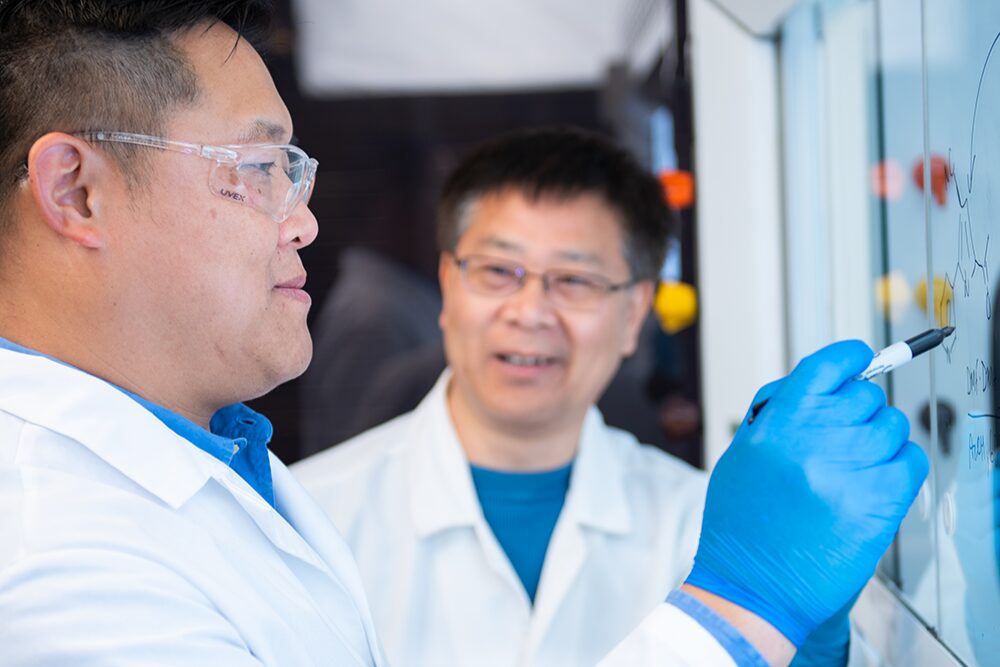
Life sciences, in particular, should represent the people that we are trying to treat as this inclusivity is integral to the kind of problem-solving that sparks ingenuity and scientific advancement for a wide variety of populations.
Common treatments for cancer today are surgery, chemotherapy, and radiation—chemotherapy and radiation can be hard on some patients. You recently dosed your first patient in a clinical trial (seven months ago) to evaluate the effectiveness of ERAS-007 for non-small cell lung cancer. What does this potential breakthrough eventually mean for lung cancer patients or cancer patients in general?
We believe that combinations of targeted therapies against the RAS/MAPK pathway can potentially improve the standard of care as well as overcome resistance. For example, in our HERKULES-2 trial, we are evaluating combination therapies with sotorasib, which is the standard of care in patients with KRAS G12C mutated non-small cell lung cancer. While directly targeting KRAS G12C has proven to be an effective strategy, six out of 10 patients unfortunately do not respond to KRAS G12C inhibitors, such as sotorasib. Analysis of patients treated with KRAS G12C inhibitors showed that a major mechanism of resistance is reactivation of the RAS/MAPK pathway via new mutations within that pathway. We hypothesize that additional blockade with ERAS-007 at ERK, which is the terminal node in the RAS/MAPK pathway, may improve the efficacy of sotorasib monotherapy. Alternatively, a second blockade with ERAS-601 at SHP2, which is critical for the cycling of the KRAS G12C mutant protein, may provide additional benefit. We are evaluating both combinations in our HERKULES-2 trial. This approach has been applied in gastrointestinal cancers, as well, in FLAGSHP-1 and HERKULES-3. We hope that our combination strategy on KRAS G12C and other targets may translate into advancements in the current standard of care across multiple tumor types.
When do you think or hope that we will get to a point where precision oncology treatments will be more widely available for patients?
Our desire at Erasca is to get precision oncology treatments to patients as soon as possible. Since the introduction of the first targeted therapies for cancer, we have made incredible progress in advancing both precision oncology treatments as well as diagnostics that enable us to identify the right patients for those treatments. There have been initial clinical successes in targeted therapies for single mutations, like entrectinib, which was approved for one of the first tissue agnostic indications—the treatment of NTRK fusion positive solid tumors. We’ve now progressed to being able to identify specific patient populations that will benefit from Immuno-oncology (I/O) therapies like KEYTRUDA. Our next big challenge is figuring out how to identify patients that will benefit from the combination of precision therapies like those found in our pipeline with I/O, chemotherapy or combinations of precision therapies and to advance these therapies through efficient clinical trials, and ultimately registration, so that patients can benefit within the next few years.
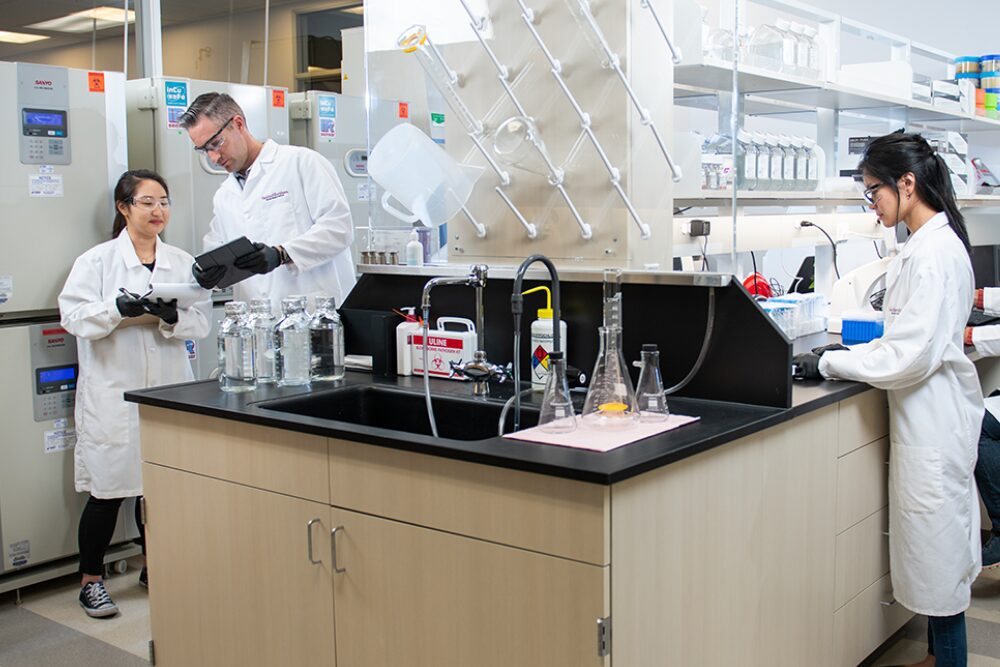
You have been the CEO and co-founder of six biotech companies, including Halozyme and Eclipse Therapeutics. What inspired you to co-found Erasca?
I have thoroughly enjoyed and learned from each of my experiences in biotech, but after the sale of Ignyta to Roche, I still felt like I had unfinished business to do in terms of developing new treatment options for patients with cancer. After reading a scientific paper on a new approach to drug the active form of RAS by Kevan Shokat and his colleagues at University of California, San Francisco, I decided to team up with Kevan to co-found Erasca. In fact, I came up with the name of the company on the very same day I read about his work. ‘Erasca’ has a dual meaning: It’s a portmanteau of our bold mission to ‘erase cancer,’ as well as our desire to ‘eradicate RAS-driven cancer.’
The company’s LinkedIn page notes that Erasca employees are referred to as ‘Erascals.’ Who came up with that name, and why? And how do you manage to do such meaningful research and innovation, yet maintain an uplifting environment in the workplace?
[Laughs]. I remember in the early days pitching two choices of what to call ourselves to our head of operations, and the term ‘Erascals’ just fit us—as well as the culture we wanted to create—much better. Erasca employees are high-performing, hard-working individuals with tremendous talent. We take our work seriously, but we try not to take ourselves too seriously. In fact, we’ve included fun as one of the key ingredients of our culture and the name Erascals conveys the playfulness we hope to embed. When employees enjoy outside activities together, it helps take away some of the stress of our work, creates a more positive environment, leads to better relationships and enhances creativity and collaboration. You’ll find us Erascals indulging in a variety of entertaining activities, whether it’s a happy hour, beach fun, a friendly game of volleyball or a special favorite: late-night karaoke jamming sessions.
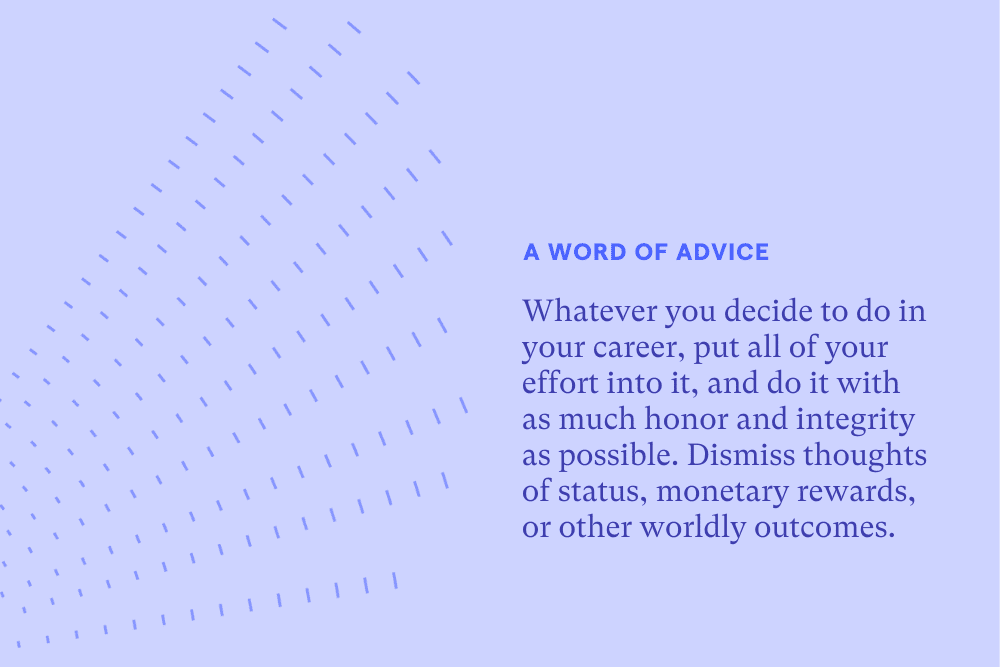
Erasca went public last summer, three years after the company launched. Can you share with us how it felt that day to see the company appear on the NASDAQ?
As amazing as it was for me personally to be leading a NASDAQ company for the third time in my career after Halozyme and Ignyta, by far the biggest impact was having the opportunity to share the experience with dozens of my fellow Erascal team members. Things were just beginning to open up again after the travel restrictions necessitated by the pandemic, so it really was a joy to not only be spending quality time together as a team, but also to be able to celebrate a meaningful company milestone together in New York City and ring the opening bell on the NASDAQ on our first day of trading. That was a memorable experience for all of us.
How did you make the transition from being a practicing surgeon into venture capital, and eventually a biotech company founder?
I feel blessed to have had the opportunity to pursue various professional passions in science, medicine, and business that have led to different ways to impact patients individually as well as on a population level. I actually transitioned from a surgical resident to a cancer epidemiology researcher at Dana Farber to a McKinsey Consultant to a biotech CEO at Halozyme before striking out on my own in late 2010 and launching a venture capital firm called City Hill Ventures, which provided me with a platform for my current profession in leadership, company building, and investing. While each career move stretched me to do something I had never done before, I learned a great deal and was able to apply cross-disciplinary learnings to each new experience, helping me to become a more effective leader. That said, it’s still an ongoing journey and I still have much to learn.
This month is Asian American and Pacific Islander Heritage Month. What does AAPI Heritage Month mean to you, and why is it important that everyone celebrates it?
I am incredibly proud of my own heritage, but I will say that it is important to not just celebrate AAPI Heritage Month, but every heritage month to celebrate the histories and contributions of various identities throughout the year. Our great nation has been built on the backs of diverse populations of people, and we enjoy our personal freedoms because of their sacrifices. Heritage months like AAPI provide all members of the community with opportunities to learn more about the people, traditions, and experiences—both past and present—of Asian American and Pacific Islanders in this country. We look forward to celebrating other people and traditions in the future as well.
What is one thing that life science companies, especially, can (and should be doing) to ensure an inclusive environment?
We are very proud of our diversity [at Erasca]. Using an informal poll at an All-Hands event, we discovered that 24 languages are spoken among our 125 Erascals. Our leadership team also reflects our diverse workforce, comprising 18 Erascals, seven of whom are women, and nine of whom are people of color. When trying to solve a problem as complex as erasing cancer, we can draw upon the richness of experiences our diverse employees’ perspectives offer. Life sciences, in particular, should represent the people that we are trying to treat as this inclusivity is integral to the kind of problem-solving that sparks ingenuity and scientific advancement for a wide variety of populations. In addition, we launched Erasca Foundation, funded with a donation of 1 percent of Erasca’s capital stock at the time of IPO. The foundation will help provide disadvantaged populations with access to national research and education opportunities, while also ensuring oncology drugs (including Erasca’s in the future) are accessible and affordable for all patients, irrespective of race, ethnicity or socioeconomic status.
What is one bit of advice that you have for young life scientists?
Whatever you decide to do in your career, put all of your effort into it, and do it with as much effort, honor, and integrity as possible. Put aside any thoughts of status, monetary reward, or other worldly outcomes. Think of this as planting seeds of toil and character for future growth, and seek to work with others who are like-minded ‘gardeners.’ As you continue planting (and pruning), you’ll be amazed by how much you will learn and grow along the way until one day, you will hopefully be standing amidst a flourishing garden. And if not, no worries—because you yourself might have become a towering fruit tree providing shelter and sustenance to those around you.
